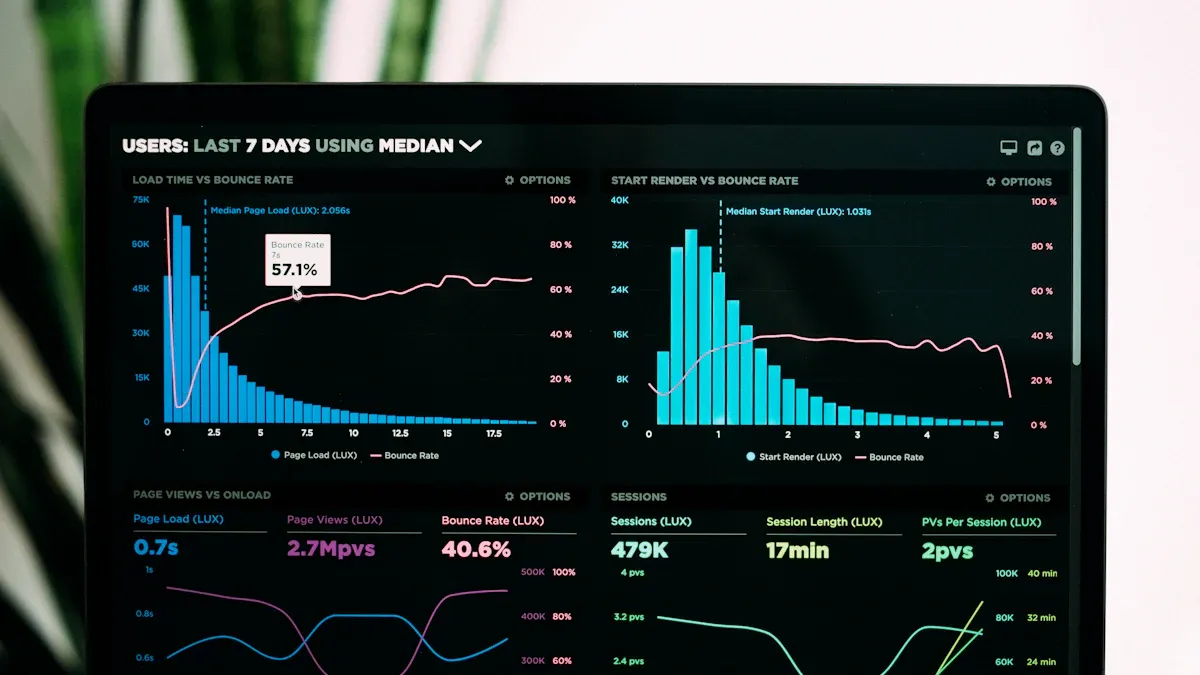
Search engines like Google increasingly rely on AI-driven systems to deliver precise results. To ensure your content stands out, focusing on AI-friendly strategies is essential. Recent studies show that websites using AI optimization techniques experience up to a 70% boost in organic traffic and a 49.2% improvement in rankings. These numbers highlight the growing importance of optimizing for AI Overviews. By structuring your content effectively and aligning it with AI algorithms, you can achieve higher visibility while enhancing user experience.
Key Takeaways
-
Write clear and organized content to help AI understand better. Use lists and titles to make reading easier.
-
Add schema markup so search engines can read your content well. This helps your content show up in AI summaries.
-
Answer common questions directly to match what users want. Make your content fit user needs for better chances of being seen.
-
Update your content often to keep it new and useful. This helps your content stay high in AI search rankings.
-
Use long-tail keywords that match detailed user searches. These specific words work better in AI summaries.
Crafting Concise and Structured Content for AI Overviews
Why AI Overviews Favor Clear and Organized Content
AI overviews rely on clarity and structure to deliver accurate summaries. Google’s AI systems prioritize content that is easy to process and directly answers user queries. Studies reveal that AI-generated summaries often average 157 words and pull information from structured formats like lists and tables. This approach ensures users receive concise and relevant information quickly.
Organized content also improves your chances of ranking higher. Research shows that 52% of sources featured in AI overviews also rank in the top 10 organic results. This connection highlights the importance of clear organization in boosting visibility. Additionally, AI systems paraphrase content instead of matching exact keywords, making natural language optimization essential.
Tip: Use bullet points, numbered lists, and headers with direct questions to make your content more digestible for AI systems.
Tips for Structuring Content to Optimize for AI Overviews
To optimize for AI overviews, focus on creating high-quality, authoritative content. Start by addressing specific user queries with direct and clear answers. Break your content into short paragraphs and use headings to guide readers. Lists and bullet points can enhance skimmability, while tables are ideal for presenting comparisons or data summaries.
Matching search intent is another critical step. Ensure your content aligns with what users are searching for. For example, if users want a how-to guide, provide step-by-step instructions. Proper formatting not only improves user experience but also increases your chances of being featured in AI overviews.
Formatting Techniques to Enhance AI Comprehension
Formatting plays a vital role in helping AI systems understand your content. Use plain language and avoid jargon to ensure clarity. Incorporate headings, bulleted lists, and numbered steps to organize information logically. Definitions of key terms can also improve comprehension for both AI and human readers.
Studies emphasize the importance of machine readability. Following best practices like using short sentences and avoiding filler content can make your content more accessible. Additionally, mobile optimization and smooth navigation enhance user experience, further improving your content’s performance in AI-driven systems.
Pro Tip: Regularly update your content to maintain freshness and relevancy. AI systems favor recent and accurate information.
Leveraging Schema Markup to Optimize for AI Overviews

The Role of Schema Markup in AI Overviews
Schema markup plays a crucial role in helping AI systems understand your content. By adding structured data to your website, you provide search engines like Google with clear context about your pages. This improves how AI overviews categorize and display your content. For example, schema markup enables AI to identify relationships between entities, such as products, reviews, or tutorials, ensuring your content matches user queries effectively.
Industry research highlights the benefits of schema markup for AI-powered search ranking. Businesses using schema markup see enhanced search engine understanding, improved user experience, and better alignment with AI-driven systems. These advantages make schema markup a key tool for optimizing for AI overviews.
Note: AI technologies can automate schema markup generation, saving you time and ensuring accuracy.
Types of Schema Markup to Use for Better Visibility
Different types of schema markup can boost your visibility in AI overviews. Product schema works well for e-commerce sites, providing detailed information like pricing and descriptions. FAQ schema improves accessibility for common questions, while review schema categorizes customer feedback to build trust. How-to schema structures instructional content, making it easier for AI systems to retrieve and display step-by-step guides.
|
Schema Type |
Impact on AI Searches |
|---|---|
|
Product Schema |
Enhances visibility for e-commerce by providing detailed product information. |
|
FAQ Schema |
Improves accessibility for common questions, making it easier for AI to provide answers. |
|
Review Schema |
Allows AI to recognize and categorize customer feedback, increasing trust and relevance. |
|
How-To Schema |
Structures instructional content for better retrieval by AI systems. |
Using these schema types can lead to more rich results in search, higher click-through rates, and improved presence in AI-powered results like Google's SGE.
Step-by-Step Guide to Implementing Schema Markup
Implementing schema markup involves a few straightforward steps. First, identify the type of schema that suits your content. For example, use FAQ schema for pages answering multiple questions or How-To schema for tutorials. Next, generate the schema code using tools like Google’s Structured Data Markup Helper or JSON-LD generators. Once created, add the code to your website’s HTML.
Healthline provides an excellent example of successful schema implementation. Their medically-reviewed content uses extensive structured data, descriptive headings, and regular updates. This approach has helped them appear in over 60% of health-related AI overviews.
Tip: Regularly test your schema markup using Google’s Rich Results Test to ensure it works correctly and aligns with Google Search Essentials.
Prioritizing User Intent to Master AI Overviews

Understanding the Connection Between User Intent and AI Overviews
AI overviews aim to deliver precise answers that align with what users are searching for. Google’s AI systems prioritize content that directly addresses user intent, ensuring searchers find relevant information quickly. To achieve this, your content must focus on clarity and relevance. High-quality content that matches user queries often ranks higher in search results and is more likely to appear in AI overviews.
Providing concise answers to common questions is essential. AI systems, such as MUM and BERT, analyze the context of queries to identify the most suitable content. By optimizing for AI comprehension, you can ensure your content resonates with both users and search engines. This approach not only improves visibility but also enhances the overall search experience.
Tip: Use natural language and avoid overly technical terms to make your content accessible to a broader audience.
Strategies for Aligning Content with User Queries
To align your content with user queries, start by understanding search intent. Users may seek information, solutions, or comparisons. Tailor your content to meet these needs. For example, if users want a how-to guide, provide step-by-step instructions with clear headings.
In-depth content performs better in AI overviews. Instead of listing tips, explore topics thoroughly to provide value. Structuring your site to reflect user needs also helps. For instance, using FAQ pages or detailed product descriptions can improve content relevancy and visibility in AI-driven search results.
-
Key strategies to consider:
-
Address specific questions with detailed answers.
-
Use structured data markup to help AI categorize your content.
-
Focus on contextual understanding to align with user intent.
-
Tools to Identify and Target User Intent Effectively
Several tools can help you identify and target user intent. Keyword research tools like SEMrush or Ahrefs reveal what users are searching for. Analytics platforms, such as Google Analytics, provide insights into user behavior and preferences. These tools enable you to refine your content strategy and ensure it aligns with user needs.
AI overviews leverage advanced models like PaLM2 to interpret search queries. These models analyze semantic nuances and prior interactions to deliver tailored results. By using tools to understand user intent, you can create content that meets their expectations and ranks higher in AI-driven search results.
Pro Tip: Regularly analyze your content performance to identify gaps and opportunities for improvement.
Additional Tips for Optimizing for AI Overviews
The Importance of Regularly Updating Content
Keeping your content fresh is essential for maintaining visibility in AI-driven search results. AI systems, including those used by Google, prioritize updated and relevant information. Regular updates ensure your content remains aligned with current trends and user needs. For instance, performing content audits helps you identify outdated sections and refresh them with new insights.
|
Evidence Type |
الوصف |
|---|---|
|
AI Preference |
AI search engines favor fresh, updated, and continuously optimized content. |
|
Content Audits |
Regular audits help identify content that needs updates, ensuring relevance. |
|
Performance Analysis |
Analyzing AI-driven search performance reveals if content is still ranking. |
By updating your content, you also improve its chances of being featured in AI overviews. Informational queries trigger AI overviews nearly 28.8% of the time, emphasizing the need for knowledge-rich and current material.
Tip: Schedule periodic reviews of your content to ensure it stays relevant and competitive.
How Internal Linking Improves AI Categorization
Internal linking is a powerful tool for improving how AI systems, like Google’s, categorize your content. Links between pages enhance navigation and help search engines understand your site’s structure. This clarity allows AI to better interpret relationships between topics, boosting your chances of appearing in AI overviews.
-
Internal links distribute link equity, helping lower-ranking pages gain visibility.
-
Well-structured linking improves crawlability, making it easier for AI to map your site.
-
Content clusters created through internal links signal expertise and topical relevance.
For example, linking a blog post about “AI tools” to a related “how-to guide” strengthens the connection between the two. This strategy not only improves user experience but also signals to AI systems that your site offers comprehensive coverage of a topic.
Pro Tip: Use descriptive anchor text for internal links to provide context for both users and AI systems.
Targeting Long-Tail Queries for Better AI Visibility
Long-tail queries are specific, multi-word phrases that align closely with user intent. AI overviews often favor these queries because they provide detailed and actionable answers. Research shows that queries with three to four words perform better in AI-driven search results.
-
AI overviews are more likely to trigger for long-tail keywords than generic ones.
-
Targeting these queries helps your content match AI’s preferred response format.
-
Users searching long-tail queries often seek in-depth, step-by-step guidance.
For example, instead of targeting “AI tools,” focus on “best AI tools for small businesses.” This approach increases your chances of appearing in AI overviews while addressing specific user needs.
Note: Use keyword research tools to identify long-tail queries relevant to your audience.
Mastering ai overviews requires a strategic approach. Focus on crafting concise and structured content that aligns with user needs. Use schema markup to help google understand your content better and improve its visibility. Prioritize user intent by addressing specific queries and providing clear answers. These strategies ensure your content ranks higher and stays relevant in google's evolving search landscape. Start applying these methods today to enhance your content’s performance and meet the demands of AI-driven systems like google.
التعليمات
What are AI Overviews in Google Search?
AI Overviews are concise summaries generated by AI systems like Google’s SGE. They provide quick answers to user queries by extracting key information from web content. Optimizing your content for these overviews improves visibility and helps users find relevant information faster.
How does schema markup help with AI Overviews?
Schema markup adds structured data to your website, making it easier for AI to understand your content. It improves categorization and increases the chances of your content appearing in AI-generated summaries. Tools like Google’s Structured Data Markup Helper simplify the implementation process.
Why is user intent important for AI optimization?
User intent determines what users want when they search online. AI systems prioritize content that aligns with this intent. By addressing specific queries and providing clear answers, you increase your content’s relevance and visibility in AI-driven search results.
Can long-tail keywords improve AI visibility?
Yes, long-tail keywords target specific user queries, making your content more relevant to AI systems. These keywords often match the detailed answers AI overviews prefer. For example, targeting “best AI tools for small businesses” improves your chances of ranking over generic terms like “AI tools.”
How often should I update my content for AI Overviews?
You should update your content regularly to maintain relevance. AI systems favor fresh and accurate information. Performing content audits every few months helps identify outdated sections and ensures your material aligns with current trends and user needs.
Tip: Use tools like Google Analytics to track performance and identify areas for improvement.







